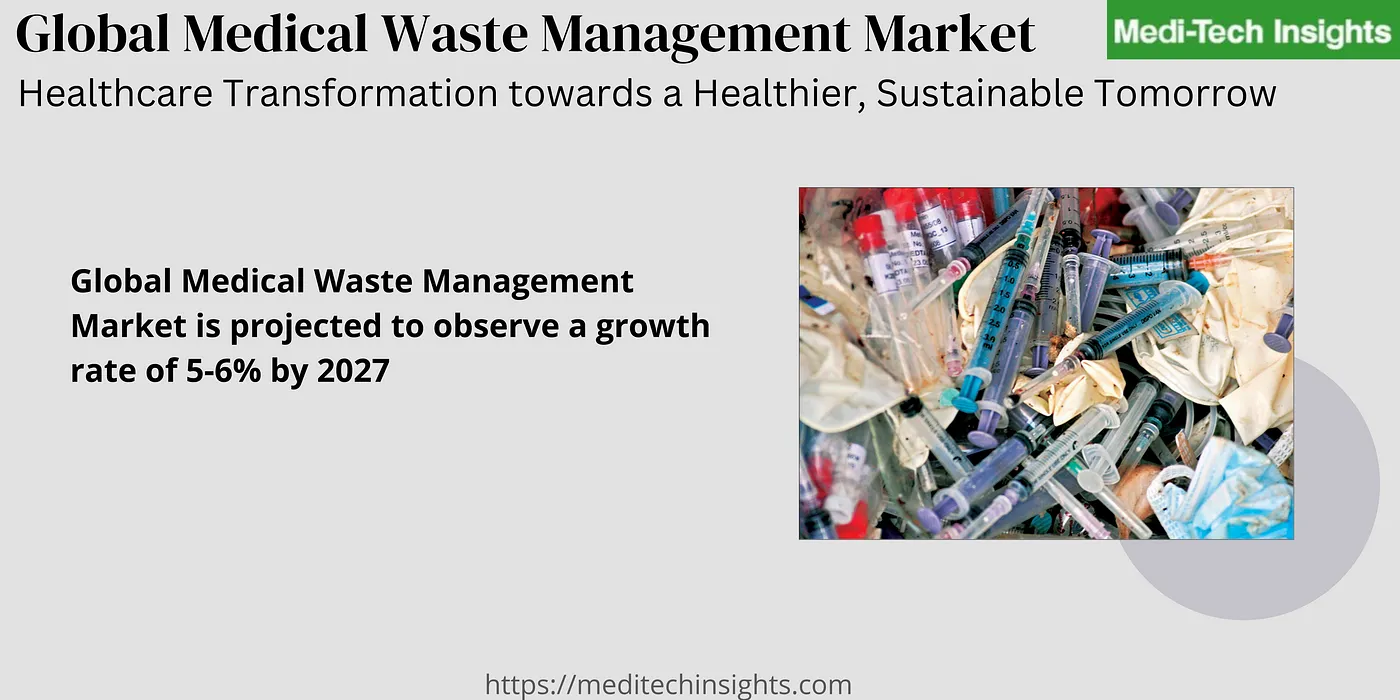Growing Amount of medical waste generated across the world, increasing utilization of single-use devices, increasing number of surgical operations, and strict regulations for medical waste management are some of the Important factors driving the growth of the global medical waste management market. However, the lack of uniform guidelines for the treatment of medical waste and the shortage of awareness regarding medical waste management in developing countries are some of the key factors that might impede the growth of the market.
Medical waste disposal refers to the specific type of garbage generated by hospitals, physician’s offices, dental practices, mortuaries, nursing homes, blood banks, veterinary clinics, medical research facilities, and laboratories. The waste is disposed of by several disposal methods such as incineration, autoclaving, chemical treatment, etc. The two types of waste are classified as
a) Hazardous Waste: Hazardous waste has properties that can have a negative impacts on Peoples health or the Nature. It is originates from infectious, pathological (tissue), sharp, chemical, pharmaceutical, cytotoxic (mutagenic, teratogenic or carcinogenic substances) or radioactive sources.
b) Non-hazardous Waste: Non-hazardous waste does not pose harm to people or the environment, and regulations governing the disposal of non-hazardous waste are relatively less stringent. Examples of non-hazardous medical waste include plastic packaging, clean glass and plastic, paper and cardboard, and office products. It contributes to about 85% of all medical waste, and ~15% is hazardous
The WHO estimates that Developed Economies produce 0.5kg of hazardous medical waste for each bed occupied in an hospital, in developing nations this is closer to 0.2kg. However, estimates are harder to come to as hazardous and non-hazardous waste are usually mixed up making the volume much higher. Proper waste disposal is required to decrease environmental risks, protect healthcare staff and prevent contamination.
Increasing Amount of Hazardous Medical Waste Drives the Global Medical Waste Management Market
Medical waste is rising as the populace and healthcare use rise, particularly in developing nations. As the global population ages and overall life expectancies rise, sickness rises as well, leading to an increase in medical waste. Other growth factors include:
· Increasing usagre of disposables — Hospitals are increasingly utilizing disposables — regular items such as catheters and scalpels are disposed of as opposed to autoclaving or UV treating them
· Prions (pathogens resistant to sterilization by autoclaving or UV) have the highest level of resistance to disinfection/sterilization. Reusable medical gadgets are more vulnerable to prions contamination. Additional concerns surrounding the rise of antibiotic-resistant bacteria are also driving the move to using disposables
· An increasing use of a variety of radionuclides in medicine and medical research has fueled the volume of biomedical radioactive waste
· Another Crucial driver for the increase in hazardous waste is due to inadequate waste management in developing economies. Incorrect disposal mixes hazardous trash with normal waste, making the general waste dangerous. This increases the overall volume of waste that must be incinerated.
Legislative Focus on the Proper Disposal of Medical Waste due to COVID-19 Outbreak is Projected to Continue to Fuel the Global Medical Waste Management Market
Covid-19 outbreak has underlined the significance of effective and safe medical waste management, placing plans for it higher on the agenda for governments. Waste generated due to Covid-19 in many countries exceeded the waste management capabilities available. During Covid-19, in the Hubei Province, China witnessed a medical waste generation rate of 0.5kg/bed/day in several hospitals, which in turn led to investments in increasing capacity and emergency solutions to waste disposal.
The Emphasis on the safe processing of waste has resulted in legislation surrounding the safe disposal of waste from governments globally, requiring effective disposal. The most often used methods are incineration, autoclaving, chemical disinfection, and microwave treatment.
Emphasis on the effective disposal of medical waste has grown
For Instance,
· Healthcare waste management was one of the biggest challenges that started due to the response to the Covid-19 pandemic. So to strengthen and safely manage infectious waste, in July of 2020, the European Union (EU) and the Pan American Health Organization/World Health Organization (PAHO/WHO) donated two medical waste autoclaves to the Ministry of Health and Wellness (MoHW) in Belize (North-eastern coast of Central America). Autoclaves are critical for effective waste management and are primarily used to sterilize infectious waste before it is disposed of in designated landfills. Through the donation of the autoclaves, the Ministry of Health and Wellness in Belize improved the hospital’s capacity for infection prevention and control with a focus on medical waste management
North America Dominates Market Share While China is Growing Fast as Companies Aim to Adhere to Chinese Regulations
The USA has a Highly-developed healthcare industry. There is also a stringent set of regulatory guidelines that healthcare providers and waste disposal companies have to comply with. Government oversight for the management of medical waste involves multiple regulatory entities including the EPA, OSHA, and individual State Departments for Environmental Protection. The EPA (Environmental Protection Agency) issued regulations surrounding emissions produced by medical waste incineration, and other methods of disposal such as microwave, chemical and electropyrolysis disposal are more commonly used — increasing demand for such services.
As China and India begin to improve the implementation of their medical waste disposal policy the medical waste disposal market is expected to see substantial growth.
Competitive Landscape Analysis : Global Medical Waste Management Market
Some of the major firms operating in the Global Medical Waste Management Market are Biomedical Waste Solutions, Clean Harbors, Inc., Daniels Health Inc., EcoMed Services, Remondis Medison (A Subsidiary of Remondis Ag & Co.Kg), Republic Services, Inc., Stericycle, Inc., Suez Environmental Services, Veolia Environmental Services and Waste Management, Inc. The market is moderately fragmented, with some large players holding substantial market share, especially in developed economies.
Explore More Curated Insights on the Global Medical Waste Management Market with a Sample Report Copy @ https://meditechinsights.com/medical-waste-management-market/

